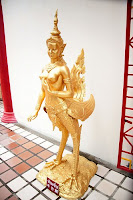Philadelphia woman flies the gay-pride rainbow flag at a Washington, D.C., march for gay, lesbian, bisexual, and transgender rights in 2000. Created in San Francisco in 1978, the flag grew in popularity after the murder of Harvey Milk (
time.com).

How we as Americans will handle the ancient experience of having a third or mixed gender in society will show the world. But we have much to learn. There is nothing new about it. While there are many stories of how odd self expression is ostracized, stories of their acceptance and integration are buried.
On this ancient land, the indigenous people had a tradition called the
berdache. Males who felt like women trapped in a female body (or presumably vice versa) were adopted into the female role and married off to a male. That male was not regarded as gay or a
berdache for marrying a man because that biological male was now socially accepted as a female in the tribe.
Much to our Puritanical consternation as Westerners and some deep gender bias, which may be biologically-rooted or completely socially-constructed, this offends us. Gender-bending is unsettling enough if we ourselves are not bisexual, pansexual, omnisexual, or questioning. But role reversal and flipping categories contrary to our birth-nature can be shocking.

In Buddhism as in Western science, gender may be fluid but biological sex is fixed. Long before the language of DNA and XX/XY chromosomes, Buddhist psychology understood that derived materiality had a sex/gender component. There is an element that determines one's biological sex at conception.
Apparently, due to karma, many things can cross wires after that. In gestation, before birth, hormones may not trigger sex stereotypical features, impulses, or reflexes. Men in India who displayed aberrant tendencies (cross-dressing, non-normative role displays, transsexuality) were labelled pandakas ("perverts," "eunuchs," "odd fellows"). We misunderstand this to mean our definition of "homosexual." But neither then nor now does this characterization fit.

It's not about homosexual, bisexual, or pansexual desires. It's about not feeling right. Rather than accepting our karmic inheritance -- which may seem very unfair (and who regards results of
past actions as "fair" in subsequent lives?) -- we struggle against it. It often makes us miserable and society, being discomfited, can be very antagonistic.
The solution is not that everyone be bisexual. It is enough that people be accepting. No one needs to be gay, but it seems we do need to be fair and kind to one another. Is reserving marriage for some and not others "fair" or "kind"?
Gays (however we wish to define it, from LGBTQ to "freaks and weirdos") have been gay no matter what society has done to them. And the aberrant behavior, drug addiction, and acting out seem to be more a reaction to poor and unfair treatment forcing secrecy than anything inherent in gender-malleable expressions.
Molestation is post-conception. It can confuse many things -- sexuality, gender roles, rage, codependency, PTSD, and so on. Molestation and nonsexual childhood trauma is the great secret of our Puritanical culture from Europe to England to America. There is a taboo to ever talk about it or its lasting aftereffects. If it expresses itself as gender-aberrant behavior, it is squashed and secreted away as indicative of the unspeakable (molestation).
Although it seems that there is much more sexual molestation going on now than in the past (within families, not by strangers), it must not have been uncommon in the past. It often leads to promiscuity, shutting down, suicide, and flamboyant parades and displays.
 Kinnar (pandakas) protesting for civil rights, Islamabad (wikipedia.org)
Kinnar (pandakas) protesting for civil rights, Islamabad (wikipedia.org)
Pandakas in India
What does Buddhism have to teach us? The Buddha was not against gays. While they were not allowed to become monastics, which entails celibacy, there was no reason in the world they could not become Buddhists or members of the
real Sangha. (The "real"community is the Noble Sangha, those who have entered upon the
stages of enlightenment even as lay followers).
Murderers (Angulimala), vain and sexually promiscuous individuals (various ancient noble nuns come to mind, such as one of the Buddha's chief disciples, Ven. Uppalavanna), lepers (Suppabuddha), slaves and outcasts, prostitutes (Ambapali) -- the Path is open to all, and everyone is capable of attaining something unless
so serious a karma absolutely frustrates their
attainment. But even so, anyone is able to make
a great deal of merit by practicing.
 What Buddhist Psychology (Abhidharma or "Higher Teachings") has to say about the determination of biological sex -- or sexual dimorphism as a quality of the material particles that make up the body -- is fascinating but probably boring. It is explained as a characteristic of "derived materiality."
What Buddhist Psychology (Abhidharma or "Higher Teachings") has to say about the determination of biological sex -- or sexual dimorphism as a quality of the material particles that make up the body -- is fascinating but probably boring. It is explained as a characteristic of "derived materiality."
An examination of it needs more expert guidance than studying biology. It is on par with particle physics. The only living expert we are aware of, and with whom we have discussed these issues, is Ven. Pa Auk Sayadaw. But he is far more interested in leading meditators to see it directly for themselves than to speak of it in abstract or hypothetical terms. So if one seeks him out, be prepared to practice virtue, sit, attain absorption, and be ready to practice insight-meditation -- in that order.
His teaching students -- Sayalay (Ayya) Susila (Malaysia), Ven. Dhammadipa (Czechoslovakia), Tina Rasmussen and Stephen Snyder (California), Shaila Catherine (California) -- might respond to inquiries regarding. But they, too, are certain to prefer speaking to sincere spiritual seekers rather than theoreticians and speculators.
There were
pandakas ("pansexuals," "perverts") in the past. There are
pandakas today. The sexism that existed before the Buddha and reasserted itself in the male-dominated Sangha (who
subordinated Buddhist nuns after the Buddha's passing but early enough to have made it seem as if the Buddha was on board and actually started that subordination by setting up extra rules,
garudhammas, for
bhikkhunis).
This gives Buddhism a black eye it does not deserve. Originally, the Dharma was not sexist. It was radically progressive in India. But the backdrop of oppression was not overcome. Males and females were segregated, and this segregation intensified in the Buddha's two Monastic Orders (male and female). Pandakas were not allowed because the goal of monasticism is to overcome sensual craving. And the promiscuity pandakas are infamous for meant people would not believe they could contain their impulses even to a normative human degree, which is hard enough.
Not only
pandakas, many groups are not allowed to become fully ordained monastics in Buddhism. For example, certain diseases prevent one, even harmless and non-transmissible ones like
vitiligo. So Michael Jackson would not have been able to become a fully ordained Buddhist monk -- even if his other aberrant behaviors (with drugs, with children, with flamboyant displays) would not have prevented him.

Wisdom Quarterly was talking to someone in India -- thanks to US corporations making so much use of customer care call centers. The operator had never heard the word "
pandaka" and had no idea there was an annual Pandaka Parade in India. That is, until a description of this word was given. Then, perfectly familiar with that, yelled out, "Oh, you mean
kinnar!"
Kinnar, as in kinnaras (garudas), the mysterious avian-hybrids of Indian mythology incorporated into Buddhist cosmology. Griffins, angels, serpent-hating-eagles, beautiful bird headed people capable of flight (in massive garuda aircraft).
Flighty "Fairies"
Wisdom Quarterly edit of Kinnar

In the culture of
South Asia,
hijras (in Islam a word related to flight and migration, Hindi: हिजड़ा,
chakka in Kannada,
khusra in Punjabi,
kojja in Telugu are physiological males who have feminine
gender identity, women's clothing, and adopt other feminine
gender roles.
Hijras have a long recorded history in the Indian subcontinent, which was formerly Buddhist and now has a massive Muslim population (of over 100 million) from the Mughal Empire period onwards. This history features a number of well-known roles within subcontinental cultures, part gender-liminal, part spiritual, and part survival.

In South Asia, many
hijras live in well-defined, organized, all-
hijra communities, led by a guru or chief.
[1][2] These communities have sustained themselves over generations by "adopting" young boys who are rejected by or who flee their family of origin (due to molestation, abuse, or rejection).
[3] Many work as prostitutes for survival.
[4]
The word
hijra is Urdu, derived from the Arabic root
hjr, has the sense of flying away, migrating, or "leaving one's tribe"
[5]. It has been borrowed into Hindi, the dominant language of India.
The Indian usage has traditionally been translated into English as "eunuch" or "
hermaphrodite," where "the irregularity of the male genitalia is central to the definition."
[6] However, in general
hijras are born with typically male physiology, only a few having been born with male intersex variations.
[7]
Historically, ceremonial initiation into the hijra community is rumored to have involved removal of a boy's penis, testicles, and scrotum, without anesthetic, at or around puberty. However, according to the Mumbai (Bombay) health organization The Humsafar Trust, only eight percent of hijra visiting their clinic are nirwaan (castrated).
Since the late 20th century, some
hijra activists and Western non-government organizations (NGOs) have been lobbying for official recognition of the
hijra as a kind of "third sex" or "
third gender," which is neither man nor woman.
[8]
 How we as Americans will handle the ancient experience of having a third or mixed gender in society will show the world. But we have much to learn. There is nothing new about it. While there are many stories of how odd self expression is ostracized, stories of their acceptance and integration are buried.
How we as Americans will handle the ancient experience of having a third or mixed gender in society will show the world. But we have much to learn. There is nothing new about it. While there are many stories of how odd self expression is ostracized, stories of their acceptance and integration are buried.
 It's not about homosexual, bisexual, or pansexual desires. It's about not feeling right. Rather than accepting our karmic inheritance -- which may seem very unfair (and who regards results of past actions as "fair" in subsequent lives?) -- we struggle against it. It often makes us miserable and society, being discomfited, can be very antagonistic.
It's not about homosexual, bisexual, or pansexual desires. It's about not feeling right. Rather than accepting our karmic inheritance -- which may seem very unfair (and who regards results of past actions as "fair" in subsequent lives?) -- we struggle against it. It often makes us miserable and society, being discomfited, can be very antagonistic. What Buddhist Psychology (Abhidharma or "Higher Teachings") has to say about the determination of biological sex -- or sexual dimorphism as a quality of the material particles that make up the body -- is fascinating but probably boring. It is explained as a characteristic of "derived materiality."
What Buddhist Psychology (Abhidharma or "Higher Teachings") has to say about the determination of biological sex -- or sexual dimorphism as a quality of the material particles that make up the body -- is fascinating but probably boring. It is explained as a characteristic of "derived materiality."  Wisdom Quarterly was talking to someone in India -- thanks to US corporations making so much use of customer care call centers. The operator had never heard the word "pandaka" and had no idea there was an annual Pandaka Parade in India. That is, until a description of this word was given. Then, perfectly familiar with that, yelled out, "Oh, you mean kinnar!"
Wisdom Quarterly was talking to someone in India -- thanks to US corporations making so much use of customer care call centers. The operator had never heard the word "pandaka" and had no idea there was an annual Pandaka Parade in India. That is, until a description of this word was given. Then, perfectly familiar with that, yelled out, "Oh, you mean kinnar!"
 In South Asia, many hijras live in well-defined, organized, all-hijra communities, led by a guru or chief.[1][2] These communities have sustained themselves over generations by "adopting" young boys who are rejected by or who flee their family of origin (due to molestation, abuse, or rejection).[3] Many work as prostitutes for survival.[4]
In South Asia, many hijras live in well-defined, organized, all-hijra communities, led by a guru or chief.[1][2] These communities have sustained themselves over generations by "adopting" young boys who are rejected by or who flee their family of origin (due to molestation, abuse, or rejection).[3] Many work as prostitutes for survival.[4]
































































































































































































































No comments:
Post a Comment